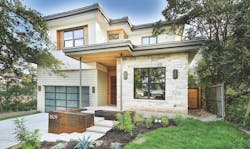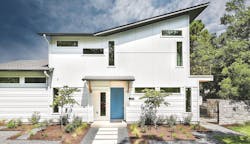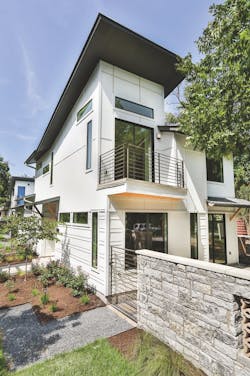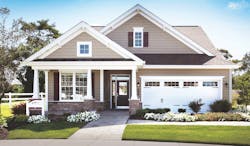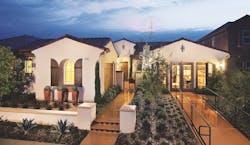In the first quarter of fiscal 2016, Lennar opened 62 communities, bringing its total to 684. CalAtlantic Group opened 55 for a total of 567. D.R. Horton’s 39 divisions currently operate in 79 markets in 26 states, and the company is seeing particularly strong growth in its Southeast region, where home building revenue was up 20 percent through the six months that ended March 31.
The relentless pursuit of land and customers among national builders consumes much of the oxygen in many of the country’s markets. Horton, Lennar, CalAtlantic, or Pulte rank first or second in active communities in 34 of the top 50 markets, according to Meyers Research data through early April. These data also show, however, that well-capitalized regional builders are still competing—and in several places excelling—with the right combinations of price points, house designs, and customer service. Aspen View Homes, in Colorado Springs, Colo., Kolter Homes, in Fort Myers, Fla., and Williams Homes, in Ventura, Calif., are among the regionals that are outpacing local, often bigger, competitors in monthly unit sales.
National builders may dominate Las Vegas, but newcomer Century Communities, which entered in 2014 through its acquisition of Dunhill Homes’ assets, is now looking at nearly doubling its sales this year, to 500 from 265 in 2015, according to Century’s Nevada division president Don Boettcher.
It would appear that many builders in all but a handful of regions are exiting, or at least minimizing, multifamily construction, which for much of the last seven years has driven the housing industry’s growth but is finally tapering off, based on permit projections. The Census Bureau estimates that, nationally, permits for structures with five or more units were down 12.4 percent in March to an annualized 324,000, or less than 30 percent of the annualized total.
Meyers Research’s forecast for permits this year shows only six of the top 50 markets—the New York City metro area, Miami-Fort Lauderdale-West Palm Beach, Los Angeles-Long Beach, San Francisco-Oakland-Hayward, Columbus, Ga.-Alabama, and San Jose-Sunnyvale-Santa Clara—where multifamily permits account for at least half of the total.
In Miami, multifamily is projected to account for more than 53 percent of total permits issued. Strong demand may explain why Related Group, which specializes in high-rises, has been averaging nearly 13 sales per month in Miami, according to Meyers Research data.
In San Jose, Calif., where multifamily permits are projected to account for just under 75 percent of the total this year, KB Home, which has been averaging more than 16 sales per month there, in April debuted Haven at Berryessa Crossing, a townhome-style condominium community with two- and three-story residences ranging from 1,372 to 2,051 square feet and from $732,554 to $926,318.
The following profiles explore how four regional builders are traveling different paths to successfully exploit their markets’ opportunities.
Design for Living
Terra Group, Miami
Miami is one of America’s art meccas. Since 2002 it has been an annual stop for the international Art Basel gallery fair and exhibition. The names of starchitects such as Bjarke Ingels, Renzo Piano, and Rem Koolhaas resonate in a city with more than its fair share of art patrons and collectors. Terra Group, a developer and builder here, appeals to Miami’s aesthetic sensibility by featuring home and interior designs developed by the studios of these and other noted architectural firms. Indeed, Terra’s website identifies the names of its designer-partners for every one of its residential projects. This is unique in an industry where design is usually anonymous. But Terra sees these connections as seminal to its marketing. “For us, it’s about the process,” explains David Martin, Terra Group’s 38-year-old president and co-founder (with his father, Pedro). “A lot of South Florida’s existing housing stock has bad architecture. So the more we can connect consumers to the design team, the better the result.”
One of Terra’s newer communities is the 121-acre Botaniko Weston in Broward County, which broke ground in April 2015 and will offer 125 single-family homes from 4,200 to 7,200 square feet, starting at $1.7 million. The firm brought in two architects, Chad Oppenheim and Roney Mateu, who designed five models. V-Starr Interiors, the design firm of tennis star Venus Williams, did the homes’ interiors. Studio Jefrë, a boutique design studio that specializes in environmental art, designed the landscaping.
Martin says his company has more than $2 billion in projects under development. Its customers split evenly between move-up buyers and international buyers looking for second homes. Over the past few years, 80 percent of its new residential construction has been single family. Terra also engages in mixed-use projects such as Doral Commons, with 140,000 square feet of retail and 319 homes ranging from $850,000 to $1.3 million.
But land is scarce in South Florida. In fact, Terra has just two big communities in the works: Pembroke Pines, a 27.4-acre property it acquired last October for $23.5 million, on which Terra intends to build a 115,000-square-foot lifestyle center and 120 single-family homes; and Pembroke Pines City Center, which will have 200,000 square feet of retail space and 400 apartments.
To locate in markets with strong employment, good schools, and access to transit, Martin sees “some urban pockets” available to build on, but concedes that Terra will need to develop projects with higher densities. He foresees single-family homes only accounting for about 50 percent of Terra’s new residential construction during the next several years.
Terra Group works with high-profile designers and architects on all its projects. At Botaniko Weston, Chad Oppenheim’s architecture celebrates South Florida’s tropical indoor-outdoor lifestyle. Image: courtesy Terra Group
Right Place, Right Time
MileStone Community Builders, Austin, Texas
Launched in 2009, MileStone Community Builders has nearly doubled its business every proceeding year. Its 620 closings in 2015 outpaced the previous year by 65 percent. And, with 22 communities serving the Austin, Texas, metro, the company is on track to close 800 homes in 2016, says its co-founder and CEO Garrett Martin.
Location is indisputably one reason why MileStone is among the industry’s fastest-growing builders. Austin’s incredible job strength and growth have set the scene for this company to thrive, Martin says. The Bureau of Labor Statistics recently noted that in February, Austin’s job growth rate—4.2 percent—was the second highest in that month for U.S. cities with more than 1 million people. And the Urban Institute projects that Austin’s population will increase by more than 30 percent through 2030.
In this burgeoning market, Martin points to MileStone’s operational excellence and its disciplined land acquisition and development strategy as competitive differentiators. Where other local production builders typically take down finished lots, MileStone develops about 90 percent of the lots on which it builds, and it owns or controls more than 5,000 lots. Over the next 18 to 24 months, it will bring online several new communities, Martin says.
One of the biggest projects this builder could be involved in is The Grove at Shoal Creek, a 75-acre property 3 miles north of downtown Austin that’s owned by ARG Bull Creek, an investment entity that paid $47 million for the land in December 2014. Last July, Martin, who co-owns ARG and is CEO of The Grove, presented the site plan for this $500 million mixed-use project. ARG is seeking Planned Urban Development zoning, which Martin explains would allow more design flexibility. The proposal includes market-rate and workforce single- and multifamily housing ranging in price from $180,000 to more than $1 million. There would be an assisted living facility, a hotel, office space, restaurants and retail, a supermarket, and an 18-acre urban park that would be one of the largest in Austin. (JHP Architecture and Overland Partners are this project’s architects, and Norris Design is its planner.)
MileStone Community Builders’ seven neighborhoods, serving a thriving Austin market, offer a variety of house plans with prices ranging from $217,990 to $388,990. Images: courtesy Milestone Community Builders
Active Adults Upsizing
Traditions of America, Allentown-Bethlehem, Pa.
The conventional wisdom among builders has long been that older or retiring buyers generally are downsizing and want new homes that are more compact. But Traditions of America, which has been building homes in Pennsylvania’s Lehigh Valley for a generation, has recently flourished with house plans for aging Baby Boomers who are looking to expand, rather than shrink, their living space.
The builder’s average home sold is around 2,400 square feet. But some buyers are stretching that up to 3,200. “We’ve identified ways to offer more structural options,” says Nathan Jameson, a partner and director of operations for Traditions of America. These include bump-outs for kitchens and bedrooms and loft expansions that are nearly as large as the home’s second-floor space.
When Professional Builder interviewed Jameson in late April, he said that the last 200 to 250 homes that Traditions of America had sold ranged from $425,000 to $450,000. Over the last two decades, the Lehigh Valley—comprising the Allentown-Bethlehem-Easton SMSA—has reinvented itself from being an area dependent on coal mining to a more vibrant economy with universities, biotech, and several corporate headquarters. This market has a large, existing demand from active-adult buyers—Traditions of America’s wheelhouse—as well as a healthy influx of 55-plus buyers who are looking for a house that’s relatively close to where they’ve previously lived. The fact that Pennsylvania doesn’t tax retirement income gives Lehigh Valley a leg up on competitive communities in nearby New Jersey and New York.
“People are moving here for lower fixed costs,” says Jameson, who attributes his company’s success to its sole focus on what he calls “55-plus lifestyle communities.” Numbers confirm the tale: Its best-selling neighborhood, Traditions of America at Saucon Valley, sold 100 homes in 17 months through April, including eight in that month alone. The builder has also enjoyed steady sales as it has expanded west, to Lancaster, Pa., and is now investing in Pittsburgh to meet demand there. While Jameson says the company is “encouraged” about the future, he worries that environmental regulations that limit density could price some buyers out of the market. “There’s a huge demand for $350,000 homes, but I don’t know how many of these we can afford to build.”
Sizable rooms and comfort are keystones of Traditions of America’s homes, which target aging Baby Boomers in Pennsylvania’s Lehigh Valley. Photo: courtesy Traditions of America
Sticking With Custom Roots
Wilson Homes, Fresno, Calif.
When Leo Wilson started Wilson Homes in 1961, it specialized in custom homes. And to this day, the company, now a production builder, maintains a staff of architects and designers that allows the builder to adjust its house plans, elevations, and colors to changing customer tastes. “We also do quite a bit of customization of our floor plans,” says Todd Wilson, Leo’s son and the builder’s vice president. Popular changes include tile and flooring upgrades and additional molding.
Wilson Homes closed 287 homes in 2015 and is shooting for more than 300 closings this year. Its single-family houses range from 1,200 to 4,000-plus square feet, and from $215,000 to more than $600,000.
The company has also built in excess of 5,000 rental apartments over the years, a number to which it expects to add 400 apartments in 2016. Leo Wilson says that the San Joaquin Valley doesn’t see a lot of rentals converting to for-sale units, although all of the company’s rentals are entitled for condominiums. Wilson says that the company has always developed its own land for home building, and currently controls more than 1,500 lots. Wilson Homes plans to open three new communities this year, each with between 90 and 150 houses.
But this being California, it’s not surprising to hear the Wilsons complain about environmental restrictions and an entitlement process that can take up to two years. (Todd singles out a rivulet called Dog Creek near one of Wilson’s communities, which he claims rarely rises higher than 6 inches. The state designated the creek “navigable” and therefore protected. “It took us three years to clear that up,” Todd says.)
Like a number of other local builders, the Wilsons are looking to nearby Clovis, Calif., for future growth. However, they don’t want to stray too far from their home base, where their company has cachet with local residents. “We’re a family business, and this is a small town,” Leo says. “We know a lot of our customers personally.” He estimates that at least 25 percent of Wilson Homes’ annual sales are with repeat customers.
Wilson Homes has sold homes in the Fresno, Calif., market for nearly 55 years, and its willingness to customize keeps house plans vibrant. Photo: Creative Noodle Photography


